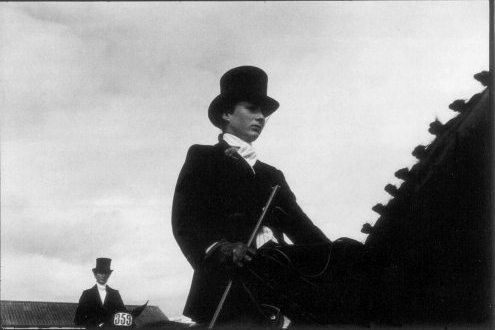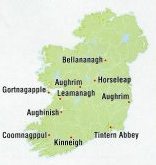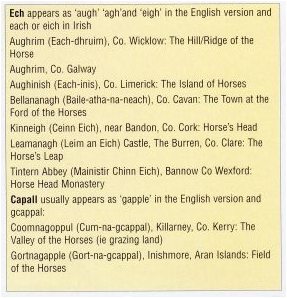|
|
Horsemen For Companions
The Horse in Ireland
By Roberta Reeners
Photographs by Rod Tuach
Few directional signs are as informative as those in Ireland where place-names are given in both English and Irish.
Could today's travelers but understand it, the Irish language may be directing them to the hill of the pig,
the goats, the barley...even the gallows.Others tell us that we are heading toward 'the foxes tail',
'the hill of the hornless cow' or 'the tomb of two deaf people'.
All speak of a past long forgotten, where hornless cows were important, when two deaf people were interred in
a place worth remembering. Hidden within these lists are many place-names which tell of horses. The ones to
watch for are those which include some form of 'capall' or 'ech'. In the Irish language both mean
'horse'---with 'capall' referring to the rugged work horse and 'ech' to the more elegant horse for riding.
How wonderful to visualize the poetry of a place which is called 'the island of horses',
'the meadow of the mare' or 'the valley where horses graze'.
In the Ireland of the Celts, there was a place for everyone... and everyone had a place, be it high or low.
There were, of course, the kings and the nobles as well as the learned class which included the judges, physicians
and musicians. Within this group, perhaps the greatest respect-- and fear--was reserved for the poet.
And the poet held great sway indeed as his very words could make or break a king. Give a poet a poor gift
for his tales of battles won, of noble and heroic deeds, and you'd had it as this little ninth century outburst shows.
He never gives fine horses
for my songs of praise.
He gives what his sort allows------cows!

And what would have been a worthy gift for this mans efforts? He says it himself: '...fine horses.'
From the time when history was merely a folk tale, the horse has played an important role in Irish culture.
It was the horse that could roam freely between this world and the land of the spirits, the 'otherworld'.
Could a man but stay on the horse's back, he too could make this journey and stay forever young. But woe to those
who touch the earth, for their fate is old age or death. The mythical hero Oisin is perhaps the best known of
those who did not survive the trek from Tir na nOg, the land of the young to the human world. As it happens,
he was unlucky because his saddle girth snapped... a twelfth-century form of equipment failure.
Too bad because the gods are ruthless and for Oisin, there was no turning back.

While few ancient legends speak of the horse in Ireland as a beast of burden, in reality it was used as a pack
animal and plough-horse. There is also little early evidence of people riding horses, unless of course, one's
status, like Oisin's, was that of 'hero'. Through most of pre-history, the horse of the legends had assumed a
sacred status, not for work or for riding, but for pulling the chariots of the gods or the high-born.
In time however, the horses potential for racing became obvious-----and 'the sport of kings' was born.
According to the legends, it was the god Lugh who brought the horse to Ireland. Lugh's special festival, Lughnasa,
was celebrated at harvest time in early August. As a means of reinforcing tribal bonds, Lughnasa was a time for
meeting, for settling arguments------and for horseracing. The low-born, the small farmers, would only
posses the reliable work-horse which probably resembled the sturdy Connemara and the Kerry Bog ponies of
today. Thus they would have been very impressed indeed at the sight of the kings fine racing stallions,
animals of immense strength and speed. Who could posses such wonderful creatures? Only someone of great
power himself. When the king and his horses arrived, any ideas of defying him went out the window.

There are still many horse fairs in Ireland at which the old idea of gathering of clans is evident.
Held in Clifden,Co Galway at the end of August every year is the Connemara Pony Show. In the past it was
a rough and ready affair, most unlike Dublin's very fashionable Horse Show Week which takes place in
early August at the Royal Dublin Society. Also in August is the fair at Muff in County Cavan and
Spancil Hill, Co Clare. Strange, those dates, each of them in August: the Irish word for this month is Lunasa!
Whether down to earth or high society, horse fairs involve a lot of horse-trading. For most people the mind
of the experienced horse-trader is a mysterious place. What do they know that we don't? What can they see that
we can't? In his excellent book, Early Irish Farming, Fergus Kelly provides some clues. His translation
of a ninth century Irish legal text speaks of 'the proper qualities of a horse'. The list is fascinating and
offers even today's trader some wise words. As to positive traits, the ideal horse should be 'swift,
high-headed...lively-hearted, broad-chested fiery...' yet 'gentle, calm narrow legged, of good stock...'.
One should, however, be wary of any animal which walks stiffly, is either too low or too tall, one that
is 'in the habit of leaping about....clumsey....lazy or lame'. The ancient admonition goes on to say that
any horse which is discovered to have these poor qualities should be returned; otherwise
'compensation is to be paid'.

But what if a horse shows potential yet insists on being troublesome? There may be an answer in the secret
skills of the horse whisperer. Not unique to Ireland, the man who can speak to horses (and it usually is a man)
is found in many traditional societies. It is only the whisperer who knows 'the word', who can speak to the soul
of the horse and bring it into perfect harmony with the human world. And the horse will understand if 'the word'
is true, for the legend says that the horse is part-human, that horse and human share a common ancestor.
Tall tales aside, The horse's hearing is keen and sharp, better than its sense of smell and certainly far
superior to its sight. So why shouldn't whispering be a perfectly sensible way of establishing a relationship?
Watch show-jumpers or jockeys, anywhere in the world, just before or after an event or race. They lean forward,
pat the animal's neck...and would seem to speak to it.
Depicted in stone on the high crosses of Christianity, shown in 16th-century woodcuts, painted in oils by
Jack Butler Yeats, the horse is ever present in Irish poetry, prose and song. Recalling his father so
beautifully in the poem 'Follower', Seamus Henry remembers that
The horse strained to his clicking tongue.
In 'Plougher, Padraic Colum speaks of
Sunset and silence! A man; around him earth savage, earth
broken; Beside him two horses...
And 'At Galway Races'. W.B. Yeats praises
...horsemen for companions, Before the merchant and the clerk
Breathed on the world with timid breath.
Yeats too, wrote for himself as the most enigmatic of epitaphs in which the horse, as it has been since
time of ancient legends, remains a powerful image.
Cast a cold eye On life, on death.
Horsemen, pass by
Roberta Reeners is a publishing consultant and journalist. Originally from Upstate New York, she
has lived and worked in Ireland for a number of years.


|